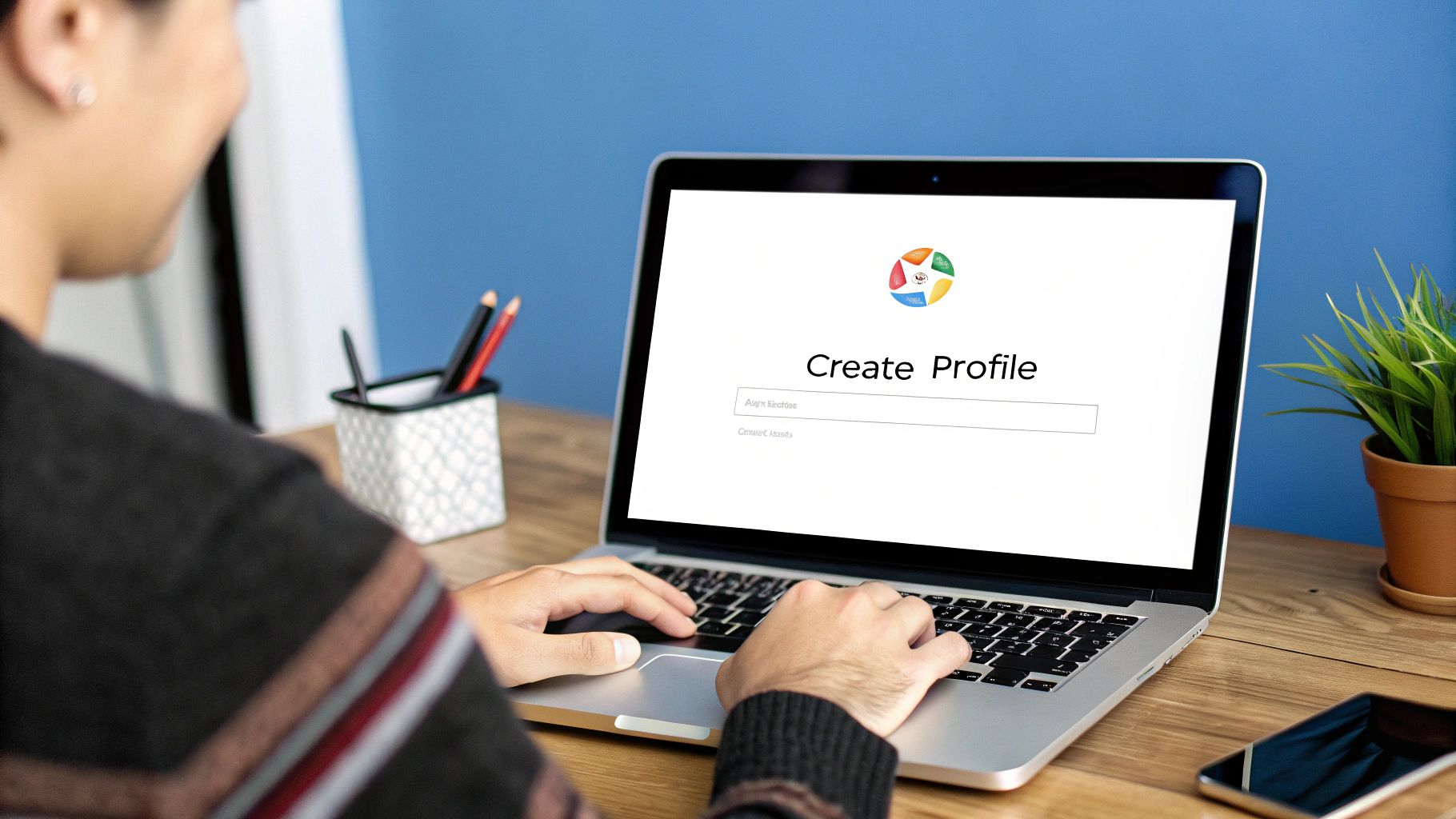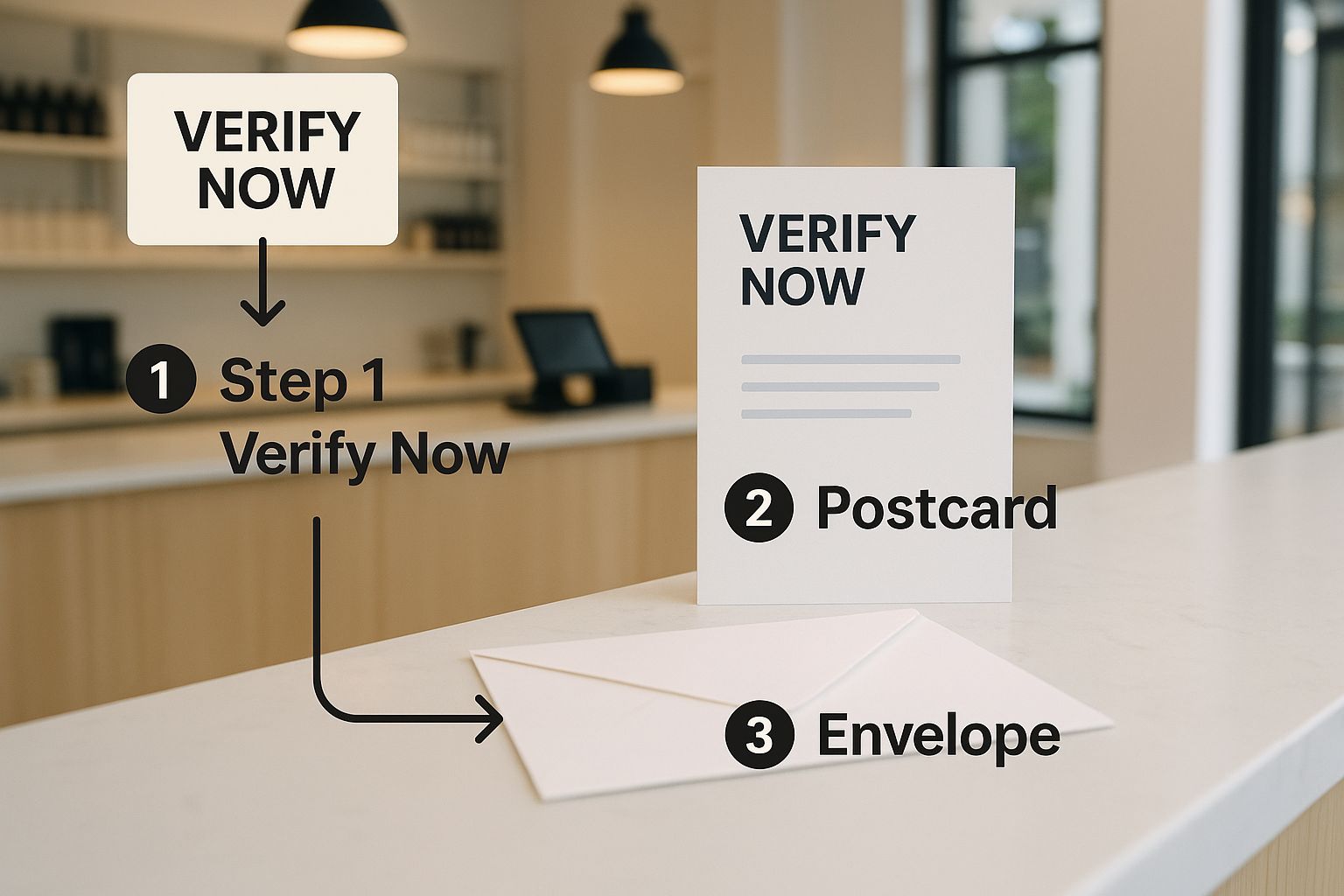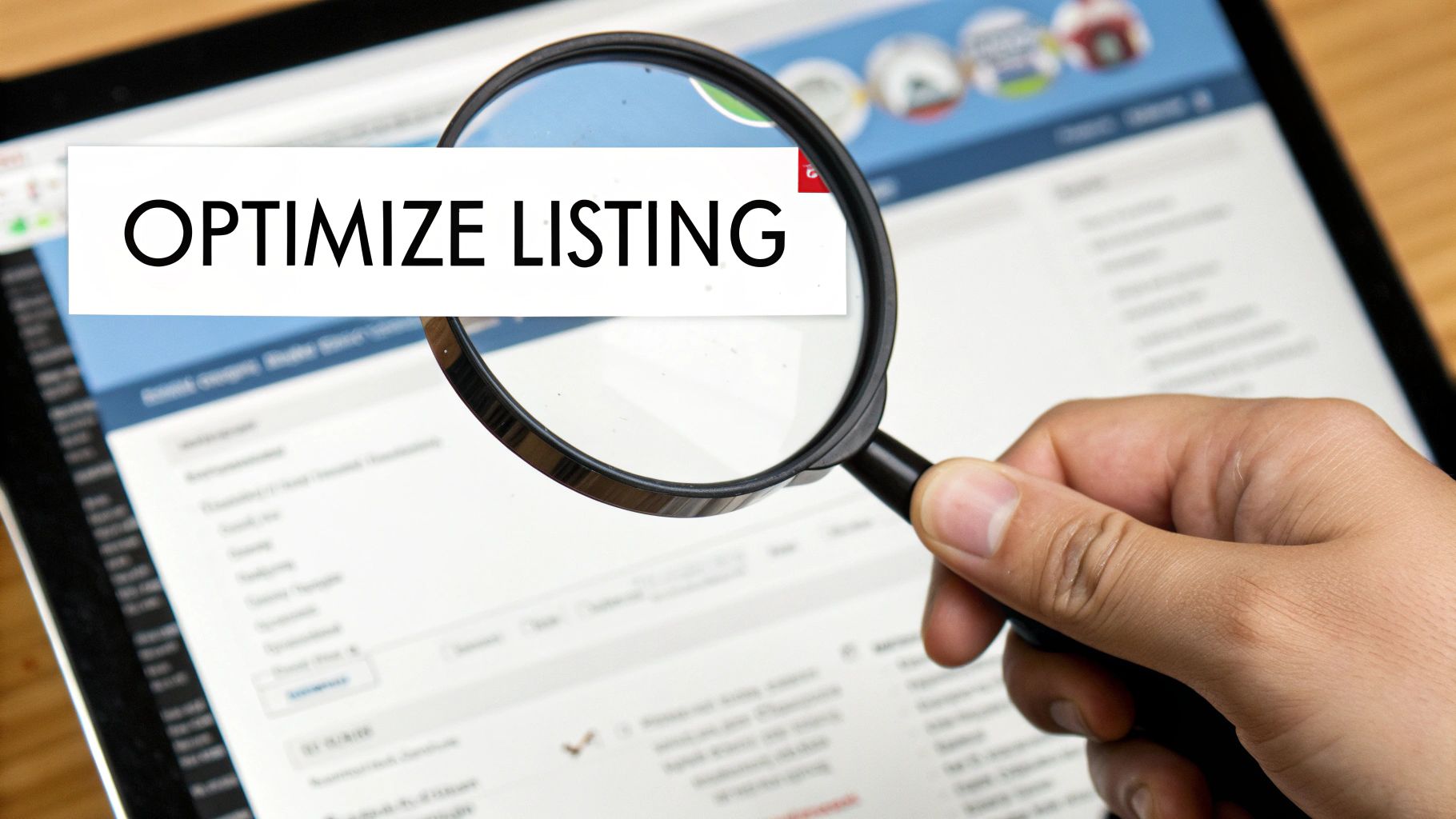
Adding Your Business to Google: Guide for Local Success
Share
If you want local chefs and restaurateurs to find you, the first and most critical step is claiming your space on Google. This starts with creating a free Google Business Profile (GBP). I can't stress this enough: think of it as your digital storefront. It's often the very first impression a potential customer has of your business when they're searching for the exact equipment you sell.
Why Your Google Business Profile Is Your Digital Storefront

Before we get into the nitty-gritty of setting it up, let’s be clear about what this profile really is. It’s so much more than just a pin on a map. For a niche business like a restaurant equipment supplier, your GBP is your hardest-working salesperson, on the clock 24/7.
When a local chef is in a panic searching for "commercial oven repair near me" or a restaurant owner is pricing out a new walk-in freezer, your profile is what pops up. It's that single touchpoint that determines whether they call you or your competitor down the street.
A complete, well-managed profile instantly builds trust and credibility. This isn't just a hunch; the numbers back it up. Customers are a staggering 2.7 times more likely to consider a business reputable if they have a complete profile. And even better, they're 50% more likely to actually buy something.
From Search to Sale: How It Works in the Real World
Picture this: the head chef at a new bistro needs a specific six-burner range, and she needs it fast. Her first move? A quick search on her phone. Suddenly, your profile appears at the top of the results, complete with:
- Sharp, high-quality photos of that exact range in your showroom.
- Your current business hours and a map to your front door.
- Glowing reviews from other local restaurants you've helped.
- A direct link to the product page on your website for more details.
This is a frictionless experience. The chef doesn't have to hunt through different websites or make extra calls. Your profile gives her everything she needs to make an informed decision, positioning you as the obvious and easiest choice.
Understanding the powerful benefits of local SEO is the key to grasping why this digital storefront matters so much. It's not just about getting found; it’s about getting chosen.
Creating Your Google Business Profile From Scratch
So, you're ready to get your restaurant equipment business on Google. The whole process starts right on the Google Business Profile homepage. It's pretty clean and simple—you'll see a button to get started, which will prompt you for your business name.
This might seem like a basic first step, but it’s actually a crucial moment. This is where you begin to stake your claim and tell Google exactly who you are and, more importantly, which customers you want to find you.

Think of this as the starting line. Getting this right is your first big step toward showing up in local searches and on Google Maps when a restaurateur is in a bind.
Choosing Your Core Business Category
One of the most important decisions you'll make right out of the gate is picking your primary business category. This one setting has a massive impact on the kind of searches you show up for. For a restaurant equipment seller, you've got a few solid options, and the best one really hinges on how you operate.
Take a look at these common choices:
- Restaurant Supply Store: This is your go-to category if you have a physical showroom. It tells Google that chefs, kitchen managers, and owners can walk in, browse your inventory, and kick the tires on a new convection oven.
- Commercial Equipment Supplier: A better fit if your model is less about foot traffic and more about B2B sales, direct delivery, and on-site installations. You might not even have a traditional storefront.
- Appliance Repair Service: If a good chunk of your business is fixing and maintaining the gear you sell (or even gear you didn't sell), you absolutely need this. It can be your primary category or a strong secondary one.
Nailing the most accurate primary category isn't just a suggestion; it’s fundamental. This is what Google uses to determine your relevance when someone searches for "commercial mixer near me."
Defining Your Location or Service Area
Next up, you'll need to tell Google where you do business. If you have that showroom we talked about, you'll enter your physical address. This is what drops that coveted pin on Google Maps, guiding customers right to your door.
But what if you don't have a showroom? Maybe you run a lean operation where you deliver and install equipment directly at restaurants. In that scenario, you’ll set up a service area. Instead of a pin, you tell Google the specific cities, counties, or even zip codes you cover. This way, you’ll show up for customers searching within that zone, even without a public-facing address.
Pro Tip: Whatever you do, don't try to cheat the system with a P.O. Box or a virtual office address. Google’s verification process is smart and will almost certainly flag it. That can get your profile suspended before you even get started. Stick to what's real and accurate.
Navigating the Google Verification Process

Alright, you've filled out the basic info. Now comes the crucial step: verification. This is simply Google's way of confirming you are who you say you are and that your business is real. It’s their quality control to protect users from fake listings and ensure the data on Maps is legit.
You can't skip this. An unverified profile is practically invisible to potential customers, so let's get it done.
Google has a few different ways to handle this, and the options it offers you will depend on your business type and the details you’ve provided. You’ll likely see one of these:
- Postcard Verification: The classic method. Google mails a postcard with a secret code to your physical address.
- Phone or Text: A much faster option where you get an automated call or text with your code.
- Email: A verification code gets sent to a business email address (e.g., you@yourequipmentcompany.com).
- Video Verification: This involves recording a short video to prove your location, equipment, and that you're a real, operational business.
Mastering Your Verification Method
If you run a restaurant equipment business with a physical showroom, you'll probably get the postcard option. It's the most common for brick-and-mortar locations. Just request the postcard from your GBP dashboard, and keep an eye on the mail for the next 5-10 business days. When it arrives, pop the code in, and you're golden.
Now, if you're primarily a service-area business doing deliveries and on-site installations, Google might ask for video verification instead. This one can feel a bit daunting, but it’s actually pretty simple if you know what to expect. They want to see tangible proof that you're a legitimate operation.
Pro Tip for Video Verification: Before you hit record, get your props ready. You’ll need to capture everything in one continuous shot. Have these on hand to show the camera:
- Your location (even a home office works)
- A branded vehicle or truck with your logo
- Tools of the trade (think dollies, installation gear, etc.)
- Proof of business, like your business license or a recent client invoice.
Don't sweat it if the postcard gets lost or your first video attempt doesn't pass muster. It happens. You can easily request a new postcard or try the video again. If you're still stuck after a couple of tries, it’s time to reach out to Google Business Profile support to get a human to help you sort it out.
Optimizing Your Profile to Win More Customers
Getting verified is just the starting line. Now, the real work begins. An optimized profile is what actually gets you customers, turning your Google Business Profile from a simple map pin into a powerful tool for your restaurant equipment business. It all comes down to the details you provide.
Your business description is prime real-tate. Don't waste it with a generic sentence. Think like a chef or restaurant owner and fill it with the exact terms they're searching for. They aren't just looking for "kitchen gear"; they're hunting for "commercial refrigeration," "stainless steel prep tables," or a specific "six-burner gas range." Weave these keywords into a compelling summary that tells them exactly why you're the right supplier for them.
Showcase Your Inventory and Expertise
I’ve seen too many equipment suppliers completely ignore the "Products" feature, and it’s a massive missed opportunity. This is your digital showroom. Don't just throw up a product name—create a detailed entry for every key piece of equipment in your inventory.
For each product, make sure you include:
- High-quality photos from several different angles. A clean, well-lit shot makes a world of difference.
- Detailed specifications, including dimensions, model numbers, and power requirements.
- A direct link to that specific product page on your website to make purchasing easy.
- Pricing information. Even a price range helps qualify leads on the spot.
This level of detail does two things: it tells Google you're a legitimate, expert supplier, and it builds trust with potential customers by answering their questions upfront. It's no surprise that 75% of top-ranking companies have a fully completed business description. It's a foundational piece of the puzzle.
To truly drive results, you need to think strategically about every part of your profile. I've broken down the most critical areas in the table below.
Key Profile Optimization Areas and Their Impact
This table highlights the most important sections of a Google Business Profile to optimize and explains why each one is critical for attracting customers.
| Profile Section | Optimization Action | Impact on Business |
|---|---|---|
| Products | Add individual listings with high-quality photos, specs, pricing, and a direct link. | Acts as a digital showroom, answers customer questions, and drives website traffic. |
| Services | Detail all value-added services like installation, repair, and consulting. | Captures high-intent searches for specific needs, differentiating you from competitors. |
| Business Description | Weave in specific, long-tail keywords that your target customers actually use. | Improves your ranking for relevant searches and quickly communicates your expertise. |
| Photos & Videos | Regularly upload photos of your showroom, products in use, and your team. | Builds trust, showcases professionalism, and gives customers a feel for your business. |
| Q&A Section | Proactively ask and answer common questions about products, financing, or delivery. | Addresses customer concerns upfront and establishes your authority on the subject. |
Treating each section with care is about more than just filling in blanks; it’s about building a comprehensive resource that actively works to win you business.
Highlighting Your Services to Stand Out
What do you offer beyond the equipment itself? The "Services" section is your chance to shine and set yourself apart from the competition. This is where you can detail all the value-added offerings that make you the better choice.
List every single service you provide. Think "equipment installation," "24/7 emergency repair," "preventative maintenance plans," or "kitchen design consultation." Adding these specifics helps you show up for much more targeted, high-intent searches.
Imagine a restaurant's walk-in cooler dies on a Friday night. A profile that explicitly lists "emergency refrigeration repair" is going to get that urgent call. This kind of strategic information is a crucial part of your overall local SEO, working hand-in-hand with things like building out your local citation profile across the web.
How to Manage Your Reputation and Engage with Customers
Once you’ve got your Google Business Profile set up and verified, the real work begins. Far too many businesses treat their profile as a one-and-done task, but that's a huge mistake. Think of it less like a static phone book entry and more like a living, breathing part of your local marketing.
This is your direct line to customers in your area. Use Google Posts to share updates that matter. Did a new line of Blodgett convection ovens just land in your showroom? Post about it. Running a special on financing for walk-in coolers this month? That’s a perfect update. These little posts keep your profile looking active, which is a great signal to both Google and anyone searching for your services.
Build Trust by Actually Talking to People
Your reviews and questions are front and center on your profile, and how you handle them says everything about your business. Staying on top of customer feedback isn't just good practice; it's essential for building a rock-solid reputation.
-
Got a great review? Don't just let it sit there. A quick, personal response goes a long way. Something like, "Thanks, Chef Sarah! We’re so glad the new Vulcan range is working out for your kitchen," shows you’re paying attention and you appreciate their business.
-
What about a negative one? These are even more important. You need to address them head-on, and fast. Acknowledge their frustration, apologize for the bad experience, and offer a direct way to make it right, like, "Please give me a call directly at..." This shows potential customers that you stand by your service, even when things go wrong.
And don't forget about the Q&A section. It’s a goldmine that most businesses ignore. You don't have to wait for someone to ask a question—seed it yourself! Think about what customers always ask you. Add a question like, "Do you offer a warranty on used equipment?" and then post a clear, detailed answer.
When you consistently engage with reviews and questions, you're not just managing a listing; you're building a foundation of trust. It shows you're a responsive, reliable partner, not just a faceless supplier shipping out boxes.
This kind of active management is what turns your profile into a lead-generating machine. On average, a well-managed Google Business Profile can drive around 200 clicks per month—that’s a mix of website visits, direction requests, and those all-important phone calls. If you're curious about the numbers, you can explore more GBP statistics to see the full impact.
Even after you’ve gone through the setup process, a few practical questions always pop up. Let’s walk through some of the most common hurdles we see restaurant equipment sellers face.
What if I have multiple showrooms?
This is a big one. If you’re managing more than one location, you don’t have to juggle separate profiles. Google lets you create Location Groups within your main dashboard.
This feature is a lifesaver. You can update your holiday hours, publish a post about a new product line, or respond to reviews for all your stores from one central hub. It simplifies everything.
What do I do when customers suggest wrong edits?
It happens. A well-meaning customer might try to "correct" your phone number or hours, and Google will notify you of the suggested change. Don't panic. You have the final say. Just log in to your dashboard, review the suggestion, and hit reject the edit.
How do I list my business if I don't have a storefront?
Many equipment businesses focus on delivery and on-site installation, without a public-facing showroom. If this sounds like you, you’ll want to set up your profile as a service-area business.
Instead of showing a pin on a map at a physical address (which you'll hide), Google will display a shaded map outlining the regions you serve—like specific cities, counties, or zip codes. This is crucial for getting your local SEO right. For a deeper dive on this, our guide on what local SEO is breaks it all down.
Remember, accuracy is your best friend. Whether you have one location or ten, keeping your information precise and current is the key to building trust with both Google and your future customers.
Ready to make your restaurant equipment business the top choice in your local market? Restaurant Equipment SEO can help. Visit us at https://restaurantequipmentseo.com to see how our specialized strategies drive real results.